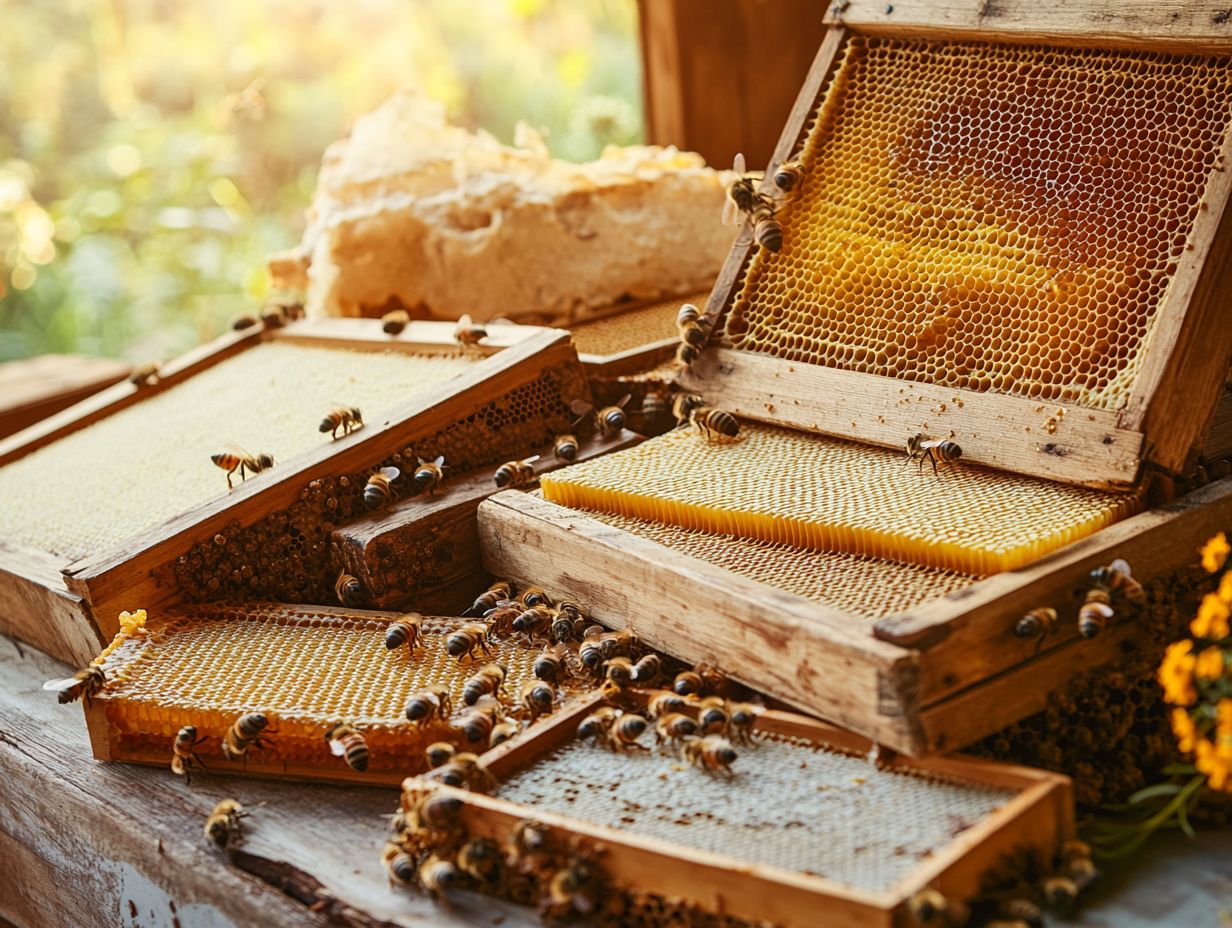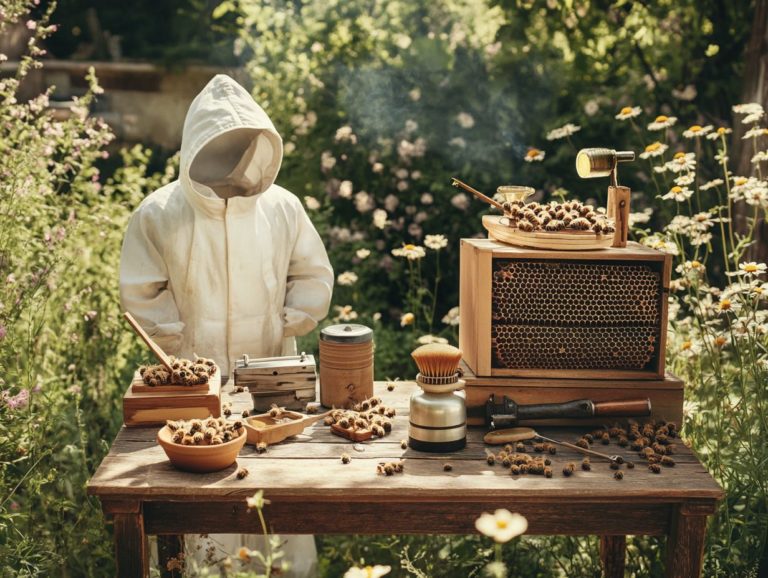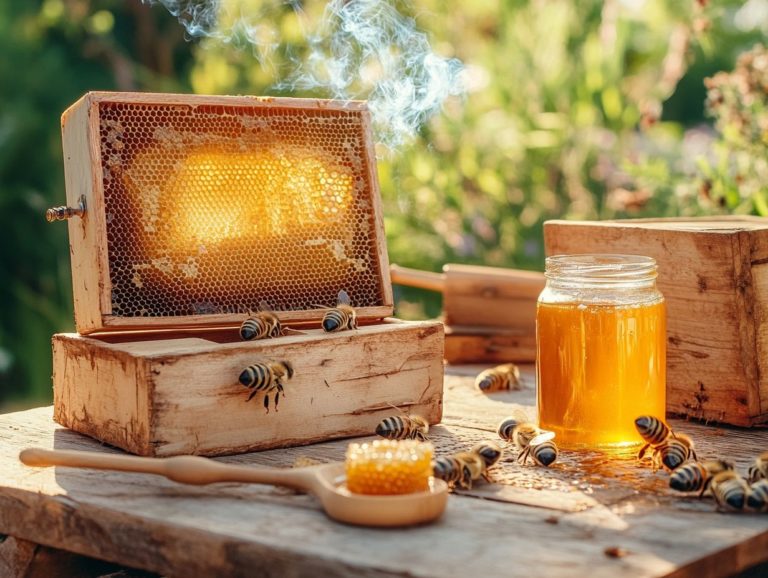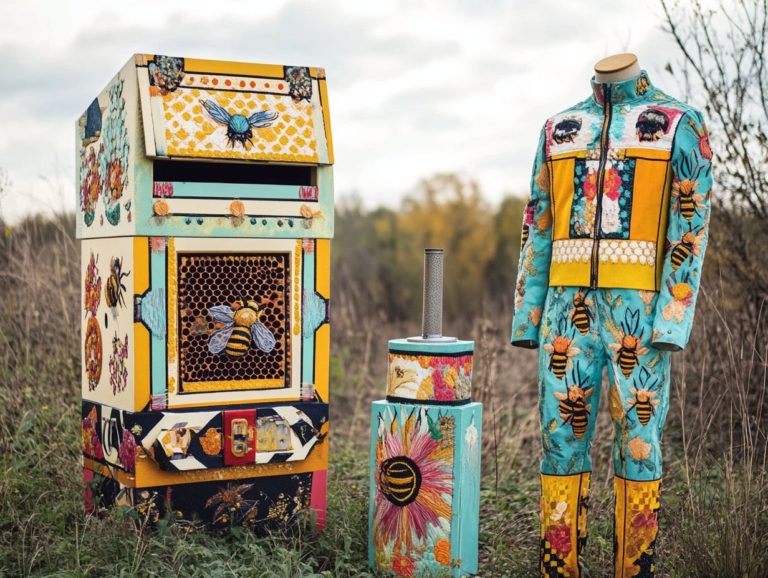Choosing the Best Frames for Honey Production
Honey production is both an art and a science, and having the right equipment is essential for a successful harvest, particularly when utilizing a Langstroth beehive.
At the core of this process are honey production frames, which provide the foundation for bees to construct their comb and store honey. This is crucial for their winter survival.
This article delves into the different types of frames available, key factors to consider when selecting the best options for your 8-frame or 10-frame hive, and essential maintenance tips to ensure their longevity.
Whether you’re a seasoned beekeeper or just beginning your journey, understanding these elements can significantly enhance your honey production experience and help you manage your apiary more effectively.
Contents
- Key Takeaways:
- What Are Honey Production Frames?
- What Are the Different Types of Honey Production Frames?
- What Are the Factors to Consider When Choosing Honey Production Frames?
- What Are the Best Frames for Honey Production?
- How to Properly Maintain Honey Production Frames?
- Frequently Asked Questions
- What are the most important factors to consider when choosing frames for honey production?
- What types of frames are commonly used for honey production?
- How do I know if a frame is suitable for my specific beehive setup?
- Are there any frames that are more beneficial for honey production than others?
- How often should I replace my frames for honey production?
- What are some signs that it’s time to replace my frames for honey production?
Key Takeaways:
- Choose durable honey production frames that fit your Langstroth beehive.
- Explore top options like Pierco plastic frames, Mann Lake wood frames, Kelley Beekeeping one-piece frames, and Dadant & Sons wire frames.
- Properly maintain your honey production frames with regular cleaning, inspection, and appropriate storage to ensure longevity.
Don’t miss out on optimizing your beekeeping experience!
What Are Honey Production Frames?
Honey production frames are essential elements of beekeeping, carefully made to house your bees and streamline honey collection. Available in a range of materials, including wax and plastic, these frames provide the foundation upon which bees construct their honeycomb.
Understanding the significance of honey production frames can elevate the efficiency of your apiary, whether you’re just starting out or managing a commercial operation. Selecting the right frames directly impacts the health of the hive, the development of the young bees, and the honey yield. This makes them a critical factor in achieving successful beekeeping practices.
What Are the Different Types of Honey Production Frames?
You’ll find a variety of honey production frames at your disposal as a beekeeper, each presenting its unique set of advantages and disadvantages regarding functionality and ease of use.
- Wooden frames, steeped in tradition, are widely favored for their classic appeal.
- Plastic frames shine in terms of durability and low maintenance.
- If you’re seeking structural support, wire frames are an excellent choice.
- For beginners aiming to streamline their beekeeping experience, one-piece frames offer a convenient solution.
Understanding these options is essential for effective hive management and maximizing your honey production.
1. Wooden Frames
Wooden frames are a timeless choice in beekeeping, celebrated for their natural properties and familiar structure. They are a dependable option for honey production.
These frames provide excellent insulation, maintaining a stable internal temperature within the hive—essential for the health of your bees and the quality of the honey they produce. Their straightforward assembly allows you, whether a beginner or a seasoned expert, to quickly set up and manage your hives without the hassle of specialized tools.
Additionally, wooden frames foster an environment that encourages the growth of natural comb, vital for the overall health of the colony. Common woods like pine, cedar, and fir are often preferred for their durability and resistance to decay. To extend their lifespan, regular inspections and occasional treatments with natural oils can safeguard the wood from the elements, ultimately enhancing your entire beekeeping experience.
2. Plastic Frames
Plastic frames are a favorite among modern beekeepers due to their durability and minimal maintenance needs. They offer a sustainable option for honey production.
These frames are delightfully lightweight, making them easy to handle during inspections or harvests. Their remarkable resistance to rot allows them to endure the elements, reducing the need for frequent replacements.
This longevity enhances convenience and boosts the overall efficiency of your hive. The smooth surfaces of plastic frames allow for easy cleaning, ensuring a healthy environment for your bees.
By opting for these innovative frames, you align your beekeeping practices with sustainability, contributing to a healthier ecosystem while maximizing your honey yield.
3. Wire Frames
Wire frames are your secret weapon for providing essential structural support to honeycomb. They are a must-have for beekeepers serious about maximizing honey production.
These frames prevent sagging or collapsing of the comb, which often occurs when excess honey adds weight. Their added stability helps ensure that the honeycomb retains its shape during extraction, crucial for effective honey management.
To install these frames effectively, make sure the wire is taut and spaced evenly. This allows for even weight distribution and minimizes the risk of collapse during peak honey production.
Don’t overlook regular maintenance; periodically inspect and tighten the wire to prevent wear or distortion. This proactive approach safeguards your hive’s performance and productivity, ensuring you get the most out of your beekeeping efforts.
4. One-Piece Frames
One-piece frames present a remarkable solution for beginner beekeepers. They streamline the setup process while maintaining effective honey production.
These frames eliminate the hassle of complex assembly, making them particularly attractive for anyone new to beekeeping. With their simple design, you can quickly become acquainted with hive management, minimizing mistakes during assembly.
This builds your confidence and enhances your efficiency when it’s time to extract honey. The user-friendly nature of one-piece frames ensures that even novices like you can manage your bees with greater ease, paving the way for a smoother and more fruitful beekeeping experience.
What Are the Factors to Consider When Choosing Honey Production Frames?
When selecting honey production frames, consider several key factors: durability, ease of use, cost, and compatibility with your current hive equipment.
Durability is crucial; it ensures that the frames can handle the weight of honey and the busy activity of bees without faltering, especially during peak honey flow. Ease of use greatly simplifies the management process, benefiting both novice and experienced beekeepers alike.
Know the costs associated with different frame types and how they fit with Langstroth beehives, a popular beekeeping design known for its ease of use. This is essential for optimizing both honey production and the overall health of your hive.
1. Durability
Durability is key when selecting honey production frames. These frames must withstand the substantial weight of honey and the constant bustle of bees.
Choosing the right material is essential. Each option—wood, plastic, and metal—has unique benefits. Wooden frames, for example, are cherished for their natural insulation properties and their ability to absorb vibrations, promoting bee health.
Plastic frames are becoming increasingly popular due to their lightweight nature and impressive resistance to water and decay, ensuring longevity even in tough conditions.
Metal frames, while strong, can swing to uncomfortable temperatures, potentially stressing your bees and impacting their productivity.
The overall strength and resilience of the frame play a significant role not just in its lifespan but also in your ability to maintain healthy hives and maximize honey production effectively, particularly during peak flow.
2. Ease of Use
The ease of use of honey production frames significantly impacts your efficiency in beekeeping. This is especially important if you’re just starting out and learning the complexities of managing hives.
Choose lightweight designs to enhance your handling experience. This allows you to maneuver with comfort and confidence.
Opting for pre-assembled frames reduces setup time, giving you more opportunity to focus on understanding bee behavior rather than dealing with assembly tasks.
Select frames that align with common beekeeping practices. This will help create a smoother transition into this rewarding hobby.
As you begin, look for features like built-in foundations and straightforward instructions. These can streamline the process and make your entry into beekeeping enjoyable and fulfilling.
3. Cost
Cost is a crucial factor when selecting honey production frames. It can vary based on materials and designs, particularly in relation to your overall beekeeping budget.
For example, wooden frames typically range from $2 to $10 each, depending on whether you choose economical pine or more durable hardwoods.
Plastic frames may come at a lower price point, but remember that they can affect the longevity and overall quality of your setup.
Your budget influences your material choices, often leading beekeepers to economy options that may sacrifice durability for a lower upfront cost.
To achieve a balance between quality and cost-effectiveness, consider investing in mid-range options that promise durability without breaking the bank.
Buying in bulk can lead to significant savings. Tapping into the wisdom of local beekeeping communities can provide valuable insights and help you make informed decisions.
4. Compatibility with Hive Equipment
Ensuring compatibility with your hive equipment is essential when selecting honey production frames. This is particularly important if you’re using a standard type of beehive, like a Langstroth.
Mismatched frames can disrupt your hive’s organization and efficiency. When frames do not fit properly, your bees may struggle to navigate the hive, impacting their ability to store honey and rear brood effectively.
Introducing frames that vary in size or style could create gaps, leading to excessive propolis buildup or even inviting pests into your hive.
Inefficient frame usage can hinder honey production, as your bees might waste energy adapting to less-than-ideal conditions.
Maintaining harmony within the hive is vital for bee health and maximizing your honey yields.
What Are the Best Frames for Honey Production?
Choosing the right frames for honey production greatly influences the health of your hive and the efficiency of honey extraction. Several reputable brands excel in this field.
Pierco plastic frames are celebrated for their durability and ease of maintenance, while Mann Lake’s assembled wood frames offer a classic touch.
If you’re new to beekeeping, Kelley Beekeeping’s one-piece frames provide a convenient option to simplify your journey.
Dadant wire frames deliver robust structural support for honeycomb. Familiarizing yourself with these options can optimize your honey production and enhance your beekeeping experience.
1. Pierco Plastic Frames
Pierco plastic frames have a stellar reputation in the beekeeping community for their durability, ease of maintenance, and efficiency in honey production.
These frames boast a unique honeycomb pattern that mimics natural beeswax, encouraging your bees to draw out the comb quickly.
Their lightweight design allows for effortless handling, reducing strain during hive inspections.
One standout benefit is their seamless integration into your existing hive systems, often matching standard sizes without modification.
Performance metrics indicate that hives using Pierco frames can achieve honey yields that rival or even surpass those from traditional wooden frames. This is largely due to the frames’ smooth surfaces, which reduce bee resistance and promote better colony health.
2. Mann Lake Assembled Wood Frames
Mann Lake assembled wood frames are an excellent choice for beekeepers like you who seek a traditional solution for honey production, blending craftsmanship with reliable performance!
These frames are crafted from high-quality wood, ensuring durability and stability over time—essential for supporting the development of honeycomb. You’ll appreciate the design that accommodates the natural behaviors of bees, promoting efficient hive management. User reviews consistently highlight how these frames excel in various hive conditions, whether you’re dealing with humid temperatures or cooler climates.
Many users have noticed that the smooth finish and precise dimensions help minimize bee propolis buildup, making inspections and maintenance a breeze! This attention to detail boosts honey yield and enhances the overall health of your hive.
3. Kelley Beekeeping One-Piece Frames
Kelley Beekeeping one-piece frames present an innovative solution for honey production, especially appealing to beginners seeking simplicity in hive management.
With a design that requires no assembly, you can focus on what truly matters—maintaining hive health and ensuring honey quality. These frames are meticulously crafted to fit seamlessly into any standard hive setup, offering stability and durability that minimizes the risk of warping or accidental damage.
As you embark on your beekeeping journey, familiarize yourself with the frame’s functionality. Consider marking the frames with identification numbers to track their age and honey storage, which will streamline your harvesting process and elevate your productivity!
4. Dadant & Sons Wire Frames
Dadant & Sons wire frames are your go-to choice if you’re a beekeeper looking to elevate honeycomb support, ensuring optimal honey production and promoting overall hive health.
These frames are built strong, providing the robustness needed to handle heavy honey loads without sagging or jeopardizing the hive’s structure. You’ll appreciate how these frames simplify honey extraction while preserving the integrity of the comb. Just remember, regular inspections and occasional wire tightening are key for maintaining peak performance over time!
Many beekeepers have reported a noticeable boost in honey yields, attributing this improvement to the frames’ durability. As you fine-tune your beekeeping practices based on shared user experiences, you’ll find that the blend of strength and low maintenance requirements makes these wire frames a critical asset in your apiculture journey.
How to Properly Maintain Honey Production Frames?
Proper maintenance of honey production frames is crucial for ensuring their longevity and effectiveness in supporting honey production. This involves regular cleaning, diligent inspection, and the right storage techniques.
As a beekeeper, routinely check for any signs of wear and tear, clean the frames to prevent disease, and store them correctly during the off-season to uphold their integrity.
Adopt these best practices to boost your honey production and keep your bees healthy!
1. Regular Cleaning and Inspection
Regular cleaning and inspection of honey production frames are essential tasks that enhance the overall health of your hive and the efficiency of honey extraction.
By maintaining these frames, you prevent the accumulation of harmful debris and foster a productive environment for your bees, ultimately leading to higher yields!
To begin, gather your essential tools: a hive tool, a brush, and a mild soap solution specifically formulated for hive maintenance.
It’s best to carry out these cleaning and inspection tasks at least twice a year, ideally during spring and fall when hive activity is more manageable.
During your inspection, be vigilant for any signs of mold, disease, or pests, as these factors can severely impact the health of your bees. Regular maintenance is your best defense against illness, ensuring that your bees remain strong and resilient, thereby enhancing their productivity and the quality of the honey they produce!
2. Replacement of Old or Damaged Frames
Timely replacement of old or damaged honey production frames is essential for maintaining the integrity and productivity of your hive.
When you notice signs like cracks, excessive wear, or a troubling buildup of mold and disease, act swiftly! Damaged frames can create unnecessary stress for your colony, impacting both honey yield and the overall health of your bees.
Old frames may also harbor pests or germs that can make bees sick that inhibit the growth of your colony, ultimately leading to diminished honey production.
For a hassle-free replacement, buy frames from trusted suppliers. Engaging with local beekeeping associations can offer valuable insights into the best brands and products to meet your specific needs.
3. Proper Storage
Proper storage of honey production frames during the off-season is crucial for maintaining their condition and ensuring they’re ready for your next beekeeping cycle.
To achieve this, consider the environmental conditions where you keep these frames. Ideally, honey frames need to be stored in a dry, cool place away from direct sunlight to prevent warping and degradation.
Protect your frames from pests and rodents to keep your bees thriving! Using airtight containers or sealing them in plastic bags offers an added layer of protection.
By following these best practices, you enhance the longevity of your frames and align with sustainable beekeeping principles, minimizing waste and ensuring your resources are preserved for future use.
Frequently Asked Questions
What are the most important factors to consider when choosing frames for honey production?
The most important factors are durability, ease of use, and compatibility with your beekeeping methods.
What types of frames are commonly used for honey production?
The most commonly used frames are wooden frames with wax foundation, plastic frames with pre-printed wax foundation, and plastic frames with pre-installed plastic foundation. Some beekeepers also consider foundationless options for their hives.
How do I know if a frame is suitable for my specific beehive setup?
Check the dimensions of the frames and compare them to your beehive to ensure a proper fit. Also, check the spacing between frames to ensure they fit well.
Are there any frames that are more beneficial for honey production than others?
It depends on your personal preference and methods, but many beekeepers find wooden frames the most beneficial as they allow for easy manipulation, and bees seem to prefer them over plastic. This preference is noted when researching alternatives for winterizing hives.
How often should I replace my frames for honey production?
Replace your frames every 2-3 years for healthy bees. Don’t wait too long—your hive’s success depends on it!
What are some signs that it’s time to replace my frames for honey production?
Signs to watch for include excessive wear, warping, mold growth, and cracks in the foundation. These issues can affect the health and productivity of your bees, especially regarding food sources like pollen and honey. Regularly check and replace frames as needed!








